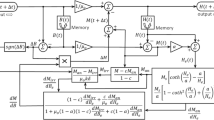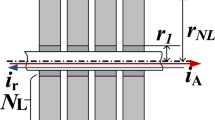Abstract
Coreless fault current limiter with variable series reactor is an emerging technology for limiting the amplitude and shortening the fault duration in the power network with simple and reversible operation. The device includes two coaxial, coreless reactors with axial mobility to vary and increase the effective inductance of the network during the short circuit fault. The reactors are automatically returned back to their initial position after the fault is cleared, with minimal net inductance. This paper aims to analytically describe the electromagnetic theory and validate the functionality of the device. For this purpose, the resistance and inductance of the device are first computed at normal condition via the basic theory of engineering electromagnetics. Next, the respective electromechanical performance characteristics such as force, positional displacement of the reactors, and the effective inductance are calculated at the faulty condition. For verification purposes, analytical results are compared against the finite element model.

















Similar content being viewed by others
Availability of data and materials
This declaration is “not applicable.”
Change history
14 October 2023
A Correction to this paper has been published: https://doi.org/10.1007/s00202-023-02061-5
Abbreviations
- V :
-
Network voltage
- λ :
-
Flux linkage
- L Line :
-
Line inductance
- L FCL :
-
FCL inductance
- R Line :
-
Line resistance
- R FCL :
-
FCL resistance
- x :
-
Position of the reactor coils
- ν :
-
Speed of the reactor coils
- e :
-
Moving induced voltage
- V m :
-
Amplitude of network phase voltage
- α :
-
Network voltage phase angle
- θ :
-
Network impedance phase angle
- ω :
-
Frequency
- Z :
-
Network Thevenin
- F :
-
Electromagnetic force
- F gravity :
-
Gravity force
- F spring :
-
Spring force
- m :
-
Reactor’s mass
- a :
-
Acceleration
- k :
-
Spring constant
- g :
-
Gravity
- ν 0 :
-
Initial speed
- x 0 :
-
Initial position
- L :
-
Self-inductance of coil
- M :
-
Mutual inductance between coils
- l :
-
Length of the coil
- r :
-
Mean radius of the coil
- N :
-
Turn number
- A :
-
Cross section of the conductor
- R :
-
Resistance of the coil
- L :
-
Self-inductance
- b :
-
Height of the coil
- h :
-
Width of the coil
- R I :
-
Radius of outer coil
- R II :
-
Radius of inner coil
- C :
-
Distance between centers of the two coils
- F(k):
-
Complete elliptic integrals of the first kind
- E(k):
-
Complete elliptic integrals of the second kind
- I 1 :
-
Current passing through outer coil
- I 2 :
-
Current passing through inner coil
- x 1 :
-
Position of the inner coil
- x 2 :
-
Position of the outer coil
- x total :
-
Distance between the two coils
References
Thippana VC, Parimi AM, Karri C (2021) Series FACTS controllers in industrial low voltage electrical distribution networks for reducing fault current levels. Int J Power Electron Drive Syst 12(4):1953–1965. https://doi.org/10.11591/ijpeds.v12.i4.pp1953-1965
Zellagui M, Hassan HA, Chaghi A, Ghorbani A (2015) A comparative study of ground fault analysis for a practical case of a transmission line equipped with different series FACTS devices. Autom Časopis Autom Mjer Elektron Računarstvo Komun 56(3):262–274. https://doi.org/10.7305/automatika.2015.12.657
Yuan J, Ye C, Zhou H, Liu J, Zheng Y, Dong W, Ni Z, Wei L (2023) A compact saturated core fault current limiter magnetically integrated with decoupling windings. IEEE Trans Power Del 38(4):2711–2723. https://doi.org/10.1109/TPWRD.2023.3255212
Zhong Y, Xie Y, Liu Y, Ye H, Yuan J, Zhou H, Wei L (2019) A novel multi-function saturated-core fault current limiter. IEEE Trans Magn 55(6):1–5. https://doi.org/10.1109/TMAG.2019.2905356
Yuan J, Gan P, Zhang Z, Zhou H, Wei L, Muramatsu K (2020) A novel six-leg three phase fault current limiter. IEEE Trans Power Del 35:1707–1715. https://doi.org/10.1109/TPWRD.2019.2950470
Yuan J, Gan P, Zhang Z, Zhou H, Wei L, Muramatsu K (2020) Saturated-core fault current limiters for AC power systems: towards reliable, economical and better performance application. High Volt 5(4):416–424. https://doi.org/10.1049/hve.2019.0049
Brandt A, Hartung KH, Bockholt R, Schmidt V (2010) Is-limiter: limitation of short-circuit currents for maximum economic benefits, ABB AG-40472 Ratingen (Germany):1–4
Sarfi V, Hemmati V, Arabshahi MM (2014) Simulation of PTC devices as fault current limiters in power systems by finite element method. In: International conference on high voltage engineering and application, Poznan, Poland, pp 1–4. https://doi.org/10.1109/ICHVE.2014.7035503
Bitencourt A, Nogueira C, dos Santos G, Dias DHN, Franca BW, Sass F, Sotelo GG (2023) Analysis and experimental tests of a solid-state fault current limiter. Electr Eng. https://doi.org/10.1007/s00202-023-01880-w
Heidary A, Radmanesh H, Rouzbehi K, Pou J (2019) A DC-reactor-based solid-state fault current limiter for HVdc applications. IEEE Trans Power Del 34(2):720–728. https://doi.org/10.1109/TPWRD.2019.2894521
Zhang J, Dai S, Ma T, Li Y, He D (2022) Current limiting characteristics of a resistance-inductance type superconducting fault current limiter. Phys C Supercond Appl 601:1354105. https://doi.org/10.1016/j.physc.2022.1354105
de Sousa WTB, Noe M, Huwer S, Reiser W (2023) Design of a 110-kV 2.0-kA smartcoil superconducting fault current limiter. IEEE Trans Appl Supercond 33(4):1–9. https://doi.org/10.1109/TASC.2023.3246818
Amini M, Damaki A, Amiri E (2021) Fault current limiter based on air core variable series reactor. IEEE Access 9:166129–166136. https://doi.org/10.1109/ACCESS.2021.3134870
Engle TG, Rohe SN (2006) A comparison of single-layer coaxial coil mutual inductance calculations using finite-element and tabulated methods. IEEE Trans Magn 42(9):2159–2163. https://doi.org/10.1109/TMAG.2006.880687
Rosa EB, Grover FW (1948) Formulas and tables for the calculation of mutual and self-inductance. US Government Printing Office, Washington, DC, p 169
Lundin R (1985) A handbook formula for the inductance of a single-layer circular coil. Proc IEEE 73(9):1428–1429. https://doi.org/10.1109/PROC.1985.13304
De Queiroz ACM (2014) Mutual inductance and inductance calculations by maxwell’s method. EE/COPEE. Federal University of Rio de Janeiro, Brazil
Tilbury M (2008) The ultimate Tesla coil design and construction guide. McGraw-Hill, New York
Yu D, Han K (1987) Self-inductance of air-core circular coils with rectangular cross section. IEEE Trans Magn 23(6):3916–3921. https://doi.org/10.1109/TMAG.1987.1065777
Babic S, Akyel C (2000) Improvement in calculation of the self- and mutual inductance of thin-wall solenoids and disk coils. IEEE Trans Magn 36(4):1970–1975. https://doi.org/10.1109/TMAG.2000.875240
Ramo S, Whinnery JR, Duzer TV (1993) Fields and waves in communication electronics, 3rd edn. Wiley, New York, pp 189–191
Ravaud R, Lemarquand G, Lemarquand V, Babic S, Akyel C (2010) Mutual inductance and force exerted between thick coils. Prog Electromagn Res 102:367–380. https://doi.org/10.2528/PIER10012806
Conway JT (2007) Inductance calculations for noncoaxial coils using bessel functions. IEEE Trans Magn 43(3):1023–1034. https://doi.org/10.1109/TMAG.2006.888565
Babic S, Akyel C (2008) Magnetic force calculation between thin coaxial circular coils in air. IEEE Trans Magn 44(4):445–452. https://doi.org/10.1109/TMAG.2007.915292
Shiri A, Shoulaie A (2009) A new methodology for magnetic force calculations between planar spiral coils. Prog Electromagn Res 95:39–57. https://doi.org/10.2528/PIER09031608
Babic S, Akyel C, Martinez J, Babic B (2015) A new formula for calculating the magnetic force between two coaxial thick circular coils with rectangular cross-section. J Electromagn Waves Appl 29:1181–1193. https://doi.org/10.1080/09205071.2015.1035807
Babic S, Akyel C (2006) New analytic-numerical solutions for the mutual inductance of two coaxial circular coils with rectangular cross section in air. IEEE Trans Magn 42(6):1661–1669. https://doi.org/10.1109/TMAG.2006.872626
Ansys (2013) Ansys Maxwell v16 user’s guide. Ansys Inc
Zhang Z, Luo Y, Wang Z, Yu D, Yang Y, Yan W, Peng H, Wu K, Yan W (2022) Research on influencing factors of magnetic property test of permanent magnetic ring. Electr Eng 104:4071–4080. https://doi.org/10.1007/s00202-022-01591-8
He B, Wu S, Wang L, Zhang J, Lin X, Meng F, Liu Y (2023) Location predictionmodel of zero value insulator based on PNN. Electr Eng 105:2347–2360. https://doi.org/10.1007/s00202-023-01794-7
Klimenta D, Jevtić M, Andriukaitis D, Mijailović V (2021) Increasing the transmission performance of a conventional 110 kV cable line by combining a hydronic concrete pavement system with photovoltaic floor tiles. Electr Eng 103:1401–1415. https://doi.org/10.1007/s00202-020-01167-4
Klimenta D, Tasić D, Perović B, Klimenta J, Milovanivić M, Andelković L (2019) Eliminating the effect of hot spots on underground power cables using cool pavements. Electr Eng 101:1295–2130. https://doi.org/10.1007/s00202-019-00867-w
Funding
This declaration is “not applicable.”
Author information
Authors and Affiliations
Contributions
All authors contributed to the whole processes including conceptualization, development of the methodology and data curation. Software: 3-D FE software package was used in this article. Writing—original draft MA wrote the original draft with the help of the other two authors. Writing—Reviews and Editing the three authors reviewed the original article and worked in the definitive article.
Corresponding author
Ethics declarations
Conflict of interest
The authors declare that they have no competing interests.
Ethical approval
This declaration is “not applicable.”
Additional information
Aliakbar Damaki Aliabad Mail: alidamaki@yazd.ac.ir
Publisher's Note
Springer Nature remains neutral with regard to jurisdictional claims in published maps and institutional affiliations.
The original online version of this article was revised: the article note has been corrected.
Rights and permissions
Springer Nature or its licensor (e.g. a society or other partner) holds exclusive rights to this article under a publishing agreement with the author(s) or other rightsholder(s); author self-archiving of the accepted manuscript version of this article is solely governed by the terms of such publishing agreement and applicable law.
About this article
Cite this article
Amini, M., Damaki Aliabad, A. & Amiri, E. Analytical modeling of fault current limiter with coreless variable series reactor. Electr Eng 106, 673–686 (2024). https://doi.org/10.1007/s00202-023-02009-9
Received:
Accepted:
Published:
Issue Date:
DOI: https://doi.org/10.1007/s00202-023-02009-9




